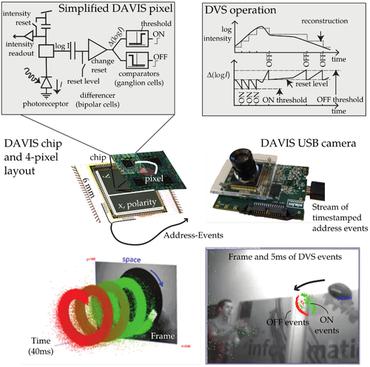Search Results for author: Marco Cannici
Found 14 papers, 8 papers with code
Mitigating Motion Blur in Neural Radiance Fields with Events and Frames
1 code implementation • 28 Mar 2024 • Marco Cannici, Davide Scaramuzza
Neural Radiance Fields (NeRFs) have shown great potential in novel view synthesis.
Low-power event-based face detection with asynchronous neuromorphic hardware
no code implementations • 21 Dec 2023 • Caterina Caccavella, Federico Paredes-Vallés, Marco Cannici, Lyes Khacef
We show that the power consumption of the chip is directly proportional to the number of synaptic operations in the spiking neural network, and we explore the trade-off between power consumption and detection precision with different firing rate regularization, achieving an on-chip face detection mAP[0. 5] of ~0. 6 while consuming only ~20 mW.
A 5-Point Minimal Solver for Event Camera Relative Motion Estimation
no code implementations • ICCV 2023 • Ling Gao, Hang Su, Daniel Gehrig, Marco Cannici, Davide Scaramuzza, Laurent Kneip
Event-based cameras are ideal for line-based motion estimation, since they predominantly respond to edges in the scene.
End-to-end Learned Visual Odometry with Events and Frames
no code implementations • 18 Sep 2023 • Roberto Pellerito, Marco Cannici, Daniel Gehrig, Joris Belhadj, Olivier Dubois-Matra, Massimo Casasco, Davide Scaramuzza
Visual Odometry (VO) is crucial for autonomous robotic navigation, especially in GPS-denied environments like planetary terrains.
Revisiting Token Pruning for Object Detection and Instance Segmentation
1 code implementation • 12 Jun 2023 • Yifei Liu, Mathias Gehrig, Nico Messikommer, Marco Cannici, Davide Scaramuzza
In relation to the dense counterpart that utilizes all tokens, our method realizes an increase in inference speed, achieving up to 34% faster performance for the entire network and 46% for the backbone.
E2(GO)MOTION: Motion Augmented Event Stream for Egocentric Action Recognition
1 code implementation • CVPR 2022 • Chiara Plizzari, Mirco Planamente, Gabriele Goletto, Marco Cannici, Emanuele Gusso, Matteo Matteucci, Barbara Caputo
However, the ever-growing field of event-based vision has, to date, overlooked the potential of event cameras in such applications.
E$^2$(GO)MOTION: Motion Augmented Event Stream for Egocentric Action Recognition
1 code implementation • 7 Dec 2021 • Chiara Plizzari, Mirco Planamente, Gabriele Goletto, Marco Cannici, Emanuele Gusso, Matteo Matteucci, Barbara Caputo
However, the ever-growing field of event-based vision has, to date, overlooked the potential of event cameras in such applications.
Neural Weighted A*: Learning Graph Costs and Heuristics with Differentiable Anytime A*
2 code implementations • 4 May 2021 • Alberto Archetti, Marco Cannici, Matteo Matteucci
Recently, the trend of incorporating differentiable algorithms into deep learning architectures arose in machine learning research, as the fusion of neural layers and algorithmic layers has been beneficial for handling combinatorial data, such as shortest paths on graphs.
DA4Event: towards bridging the Sim-to-Real Gap for Event Cameras using Domain Adaptation
no code implementations • 23 Mar 2021 • Mirco Planamente, Chiara Plizzari, Marco Cannici, Marco Ciccone, Francesco Strada, Andrea Bottino, Matteo Matteucci, Barbara Caputo
Event cameras are novel bio-inspired sensors, which asynchronously capture pixel-level intensity changes in the form of "events".
Spatial Temporal Transformer Network for Skeleton-based Action Recognition
1 code implementation • 11 Dec 2020 • Chiara Plizzari, Marco Cannici, Matteo Matteucci
Skeleton-based human action recognition has achieved a great interest in recent years, as skeleton data has been demonstrated to be robust to illumination changes, body scales, dynamic camera views, and complex background.
Skeleton-based Action Recognition via Spatial and Temporal Transformer Networks
1 code implementation • 17 Aug 2020 • Chiara Plizzari, Marco Cannici, Matteo Matteucci
Skeleton-based Human Activity Recognition has achieved great interest in recent years as skeleton data has demonstrated being robust to illumination changes, body scales, dynamic camera views, and complex background.
A Differentiable Recurrent Surface for Asynchronous Event-Based Data
1 code implementation • ECCV 2020 • Marco Cannici, Marco Ciccone, Andrea Romanoni, Matteo Matteucci
Dynamic Vision Sensors (DVSs) asynchronously stream events in correspondence of pixels subject to brightness changes.
Attention Mechanisms for Object Recognition with Event-Based Cameras
no code implementations • 25 Jul 2018 • Marco Cannici, Marco Ciccone, Andrea Romanoni, Matteo Matteucci
Event-based cameras are neuromorphic sensors capable of efficiently encoding visual information in the form of sparse sequences of events.
Asynchronous Convolutional Networks for Object Detection in Neuromorphic Cameras
no code implementations • 21 May 2018 • Marco Cannici, Marco Ciccone, Andrea Romanoni, Matteo Matteucci
Event-based cameras, also known as neuromorphic cameras, are bioinspired sensors able to perceive changes in the scene at high frequency with low power consumption.











